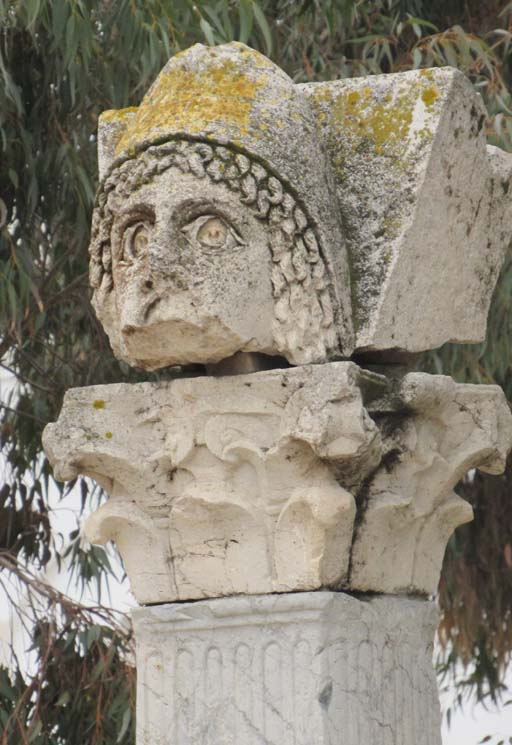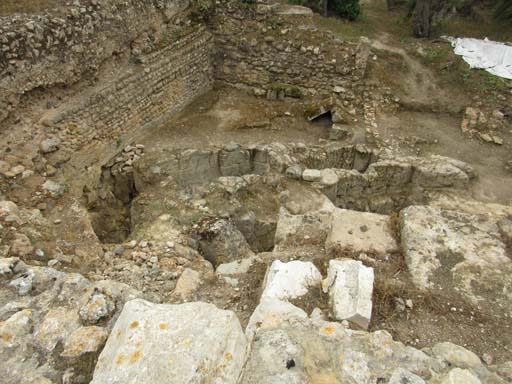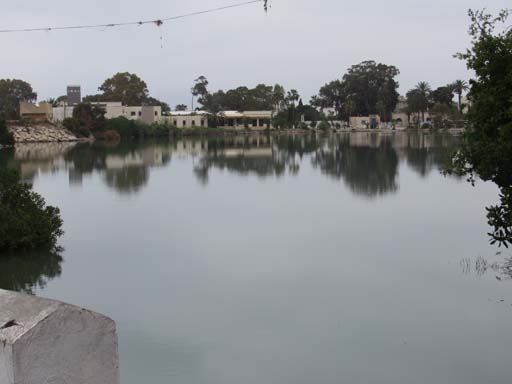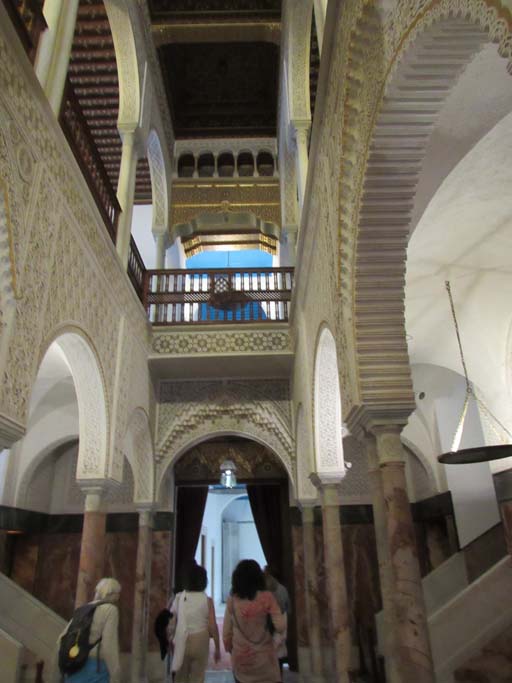We return, after I’ve caught up with some of the sleep I lost at Toolbox, to Mediterranean adventures.
Saturday was the worst day. Kathy’s COVID was peaking, and her ribs were aching and she was coughing continually, and I was a long way off and unable to help. I was exhausted and stressed and pretty well needed to spend the day in a cool, dark room listening to soothing music. That wasn’t going to happen.
Le Bougainville crossed from Porto Empedocle to Tunis overnight, and I watched through my cabin window as we came into the port. From the boat Tunis looked like any other Mediterranean port: ochre-colored stone, low buildings, whitewashed walls. Cloud stretched from horizon to horizon, but the day was incredibly sultry, and as soon as I stepped out of doors I was bathed in sweat. My injured knee was acting up, and my feet and legs were hurting as well.
But yet I was taking my first (painful) steps on the African continent, and we were going to see Carthage— or what was left of it— and a few other choice thing as well.
The first thing we noticed was that we had a police escort, several heavily-armed chaps on motorcycles. I was told two different stories about why they were there. The first was that any group of foreigners got an escort. The second was that a Ponant ship had never called prior to this, and they wanted to impress the Ponant company with their security precautions.
Were the security precautions actually needed? I haven’t heard about Tunisians attacking visitors, and the place seemed full of hospitality, but then I suppose they know best. In any case, I never felt in any danger.
The first thing we saw of Carthage was a cemetery— not the fabled Tophet of supposedly sacrificed children, but a later Roman graveyard. The bird/woman/thing in the above photo was a cenotaph in the Roman burial ground.
There isn’t much of old Carthage left, what with the Romans having destroyed it and all. There was the robust ruins of a housing development of the 2nd Century known as the “Hannibal district,” though Hannibal probably didn’t have anything to do with it. And eventually we came to the Tophet, filled with the graves of cremated children.
These children were allegedly sacrificed to someone or something spelled mlk, traditionally “Moloch.” Moloch is customarily believed to be a Phoenician deity, and the prophets of the Hebrew Bible saved some of their choicest rhetoric for anyone sacrificing their children to him. Archaeologists have since suggested that mlk may not have been the deity, but the sacrificial ritual itself, and some have gone further to say there was no real sacrifice involved, just a ritual “passing through the flame” in a sort of fiery baptism.
While there is no direct evidence of child sacrifice, still there’s a whole cemetery dedicated to cremated kids, and you don’t see that in any other culture. Also, all of Carthage and Phoenicia’s neighbors believed they sacrificed their young, and wrote about it with various degrees of indignation. So I think they probably really did kill their kids, though possibly only in times of great trouble.
Nearby is a statue to St. Louis, and also a graveyard effigy. Louis IX isn’t actually buried there, but most of him is in St. Denis with the other French kings, while his heart and intestines reside in the cathedral of Monreale near Palermo, which I saw a few days later. Louis died besieging Tunis while leading the Eighth Crusade. (His Seventh was equally successful.)
Louis seems to have had a very bad sense of direction. His aim was to liberate Jerusalem, but he felt he needed a base nearby from which to launch his campaign. During the Seventh he tried to capture Cairo, and lost his whole army. During the Eighth he tried to capture Tunis, but it’s on the wrong side of the Mediterranean from Jerusalem, and I’m not sure how it’s a base for anything other than maybe an assault on Sicily. Aside from which the Crusader kingdom still held ports in the Holy Land, like Acre and Jaffa, and if Louis wanted a base, it was ready-made. His motivation for all this seems a little obscure.
His statue makes Louis look a little bewildered. Maybe the artist had a point.
The most impressive remains of Carthage are its ports, or cothon in Punic. Carthage had two ports: a rectangular commercial port reached through a short passage to the sea, and a doughnut-shaped military port, connected to the first by a canal, that featured the sheds in which 220 warships could be sheltered.
The military port remains today, now a horseshoe lake, the circular island now a peninsula. (It became a commercial port at some point, but since Tunis has a modern port, the old port now seems to be a picturesque backwater.)
After the refreshing views of the old port, we went to see the remains of the Roman city. Scipio Aemilianus had torn down the Punic city, pronounced a curse on anyone rebuilding it, and sowed at least some ground with salt (presumably a small field, since he could hardly cover all Tunisia in rock salt), all of which might have you thinking that settled the matter. Caesar Augustus, ignoring all that, ordered the city rebuilt under its old name— its location was simply too good to ignore, and Roman Carthage became one of the largest and richest cities in the empire.
There was a Roman theater, which looks very like Roman theaters everywhere , and the colossal Baths of Antoninus, build in the second century. By this point I was in considerable pain and my body was pouring sweat. I’d gone through several water bottles and was going to go through several more. I decided that I’d seen enough Roman baths in my life (true enough, really) and limped off to the bus, where I could sit under the air conditioning and chug more drinking water.
By and by the bus took us off to the posh suburb of Side Bou Said, built on the sides of various hills, with each building painted white with distinctive blue trim. The views of the ocean from atop the hills, looking down on the yacht basin and beaches, were striking and lovely. We disembarked and walked up a long drive to the house of Rodolphe François Baron d’Erlanger, a Frenchman with a noble German title, who had been told to move to North Africa for his health around 1912. As he came from a rich banking family, he promptly built himself a white-and-blue palace, which inspired his neighbors to adopt the same color scheme. (The entire village looks as if it’s participating in some unlikely tribute to the Greek flag.)
The palace is called Ennejma Ezzahra, or Star of Venus, and it’s a wonderful tesseract of a house, unpacking itself in all sorts of unlikely directions. The rooms of the baron and his family are quite modest, but then they’re set into a house that’s full of marble, plaster arabesques, paintings, a lovely wood-screen gallery surrounding the atrium, mosaics, carpets, objets d’art, and ceramics.
The baron was a painter and a musicologist, and his aesthetic has imprinted itself on his house. His paintings are where he placed them on the walls. As a musicologist, he had a considerable influence on the revival of certain forms of Arab music, helped organize the first Congress of Arabic Music, and also wrote an influential six-volume description of Arab and North African music.
His house is now the headquarters of an institution devoted to the study of Arabic music, which operates under the Tunisian government.
The baron’s personal collection of instruments occupies several rooms. I wished I’d had more time to view them all.
I wandered through the house for as long as my knee and other ailments permitted. I was in considerable pain, particularly on the stairs, and also I was beginning to miss lunch. I definitely needed an infusion of calories as well as an opportunity to sit down.
We walked back along the drive to the bus, and were taken into Tunis in the general direction of a meal. We were obliged to walk uphill through a narrow souk (assuming there’s any other kind), and my knee wasn’t enjoying this at all. Normally I would have enjoyed strolling through the souk and looking at the various products on offer, but I was focused more on staying upright and finding some shade to hide in.
I found the restaurant and collapsed at my table. I don’t remember the meal, except that it was lamb. Then it was down the hill through the souk to get on board the bus again. There was an option of visiting another, larger souk, but I’d pretty much exhausted my knee’s patience, and I wasn’t interested in buying anything anyway.
Back on the Bougainville I changed out of my sweat-soaked clothing and dived into the swimming pool, as a way of washing away the sweat and cooling down at the same time. The pool was very small— two strokes and you’d cross it— and I never saw anybody else use it.
After a shower the bed called, and I crashed till dinnertime.
Things could only improve from here.






{ 1 comment… read it below or add one }
Tunis and Carthage are both on the long version of my bucket list. But my left knee was aching in sympathy with yours by the time I got done reading this. Glad you were able to fortify yourself mid-day.